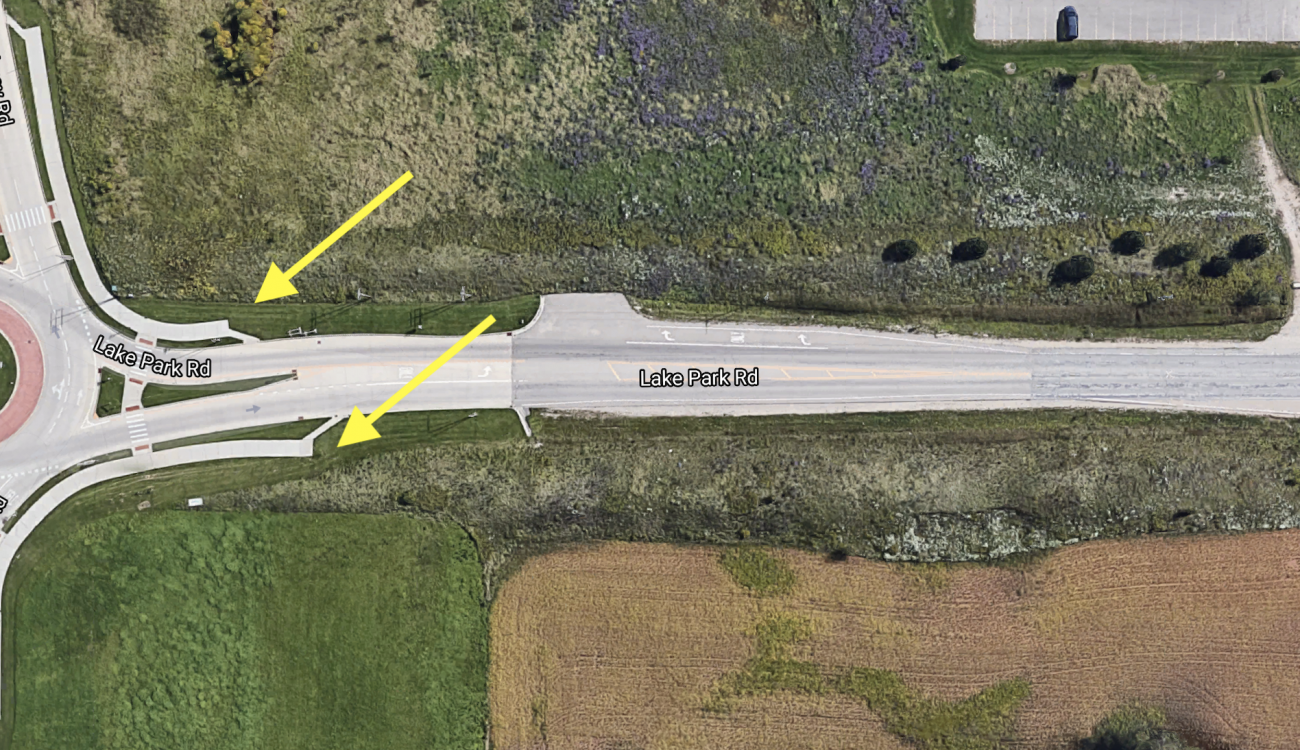The Wisconsin Bike Fed encourages the restoration of local powers to use eminent domain for bicycle and pedestrian facilities. In the photo above you can see where the sidewalks end because the reconstruction of Lake Park Rd is being held up because of the change in state laws.
In 2017, Act 59 of the state budget included a provision prohibiting use of eminent domain for pedestrian ways, bicycle lanes and recreational trails. The 2019 proposed state budget bill included language restoring these important provisions, but that language did not make it into the final budget, 2019 Wisconsin Act 9.
“Eminent domain” refers to the power of a sovereign state over property within its borders. The U.S. Supreme Court has described the power of eminent domain as an inherent “attribute of sovereignty” rather than a power which must be constitutionally conferred.
Wisconsin’s eminent domain rules were included in Article 1, Section 13 of our state constitution, which was ratified in 1848. Wisconsin law empowers a range of entities, public and private, with condemnation authority. Counties, towns, villages, cities, school districts, and certain state entities may exercise condemnation authority for “any lawful purpose”
Although eminent domain is rarely used, without it, communities may not be able to move forward with projects. For example, the change is holding up a $5.5 million federally funded plan for major improvements along a stretch of Lake Park Road in Calumet County. Those plans call for widening the road to add a center turning lane, and bike lanes, a recreational trail on one side of the roadway, and a sidewalk on the other.
The new cross section will align with similar improvements recently completed by the city of Appleton just up the road. The sidewalk and path are required to use the federal funds. Sen. Roger Roth, R-Appleton, supports the project and is hoping to come up with legislation to fix the unintended consequences of the 2017 language that was slipped into the budget bill.
The current law is costing counties and municipalities money and creating delays on 17 projects, including one Highway project because of federal requirements for bicycle and pedestrian facilities. “I don’t think we saw the unintended consequences of what we’re seeing right now. And that’s why I’m working on a fix to that,” said Roth.
Roth says the intention of the legislation was to prevent local governments from cutting through private property without permission. He says for safety along roadways eminent domain is a different story. “That area has seen some explosive growth over the last 20 years. You cannot walk that road safely, there are just not enough amenities there to do that,” said Roth.
Separated bikeways (protected bike lanes and paths) have been proven to increase safety for all road users.
- A 2016 study done by the Transportation Research Board for the Federal Highway Administration found of the 18 sites where protected bike lanes were added, 14 locations saw a decrease in both crashes for all road users in addition to significantly reduced bicycle crashes.
- A 2019 study published in the Journal of Transport & Heath that reviewed 13 years of crash data from 12 large US cities found those with the highest number of separated bicycle facilities had 44 percent fewer fatal crashes for all road users, including people on bikes, walking and in motor vehicles.4
- When protected bike lanes were installed in New York City, injury crashes for all road users (drivers, pedestrians, and cyclists) decreased by 40 to 50 percent.3
Our eminent domain laws already have robust protections for private land owners by requiring:
- A determination of necessity
- Negotiation & two appraisals at public expense
- An appeals process
Bicycle and pedestrian facilities are good for business.
A study commissioned by the Walton Foundation found the $38 million investment in trails in northwest Arkansas generates a $137 million annual return.5
New trails in Cuyuna Country State Recreation Area in the struggling Minnesota iron range now annually attract 185,000 visitors, add $2 million to the local economy, have resulted in 15 new businesses opening and job growth has doubled in the towns of Crosby and Ironton.6
The current law is costing counties and municipalities money, creating delays on at least 17 projects, including the highway project in Calumet County mentioned above, and our existing protections for property owners have proven effective since 1948
Our Ask:
The Wisconsin Bike Fed asks that our legislature restore the powers of local governments to use eminent domain.
Keep Wisconsin Biking Strong!
Wisconsin Bike Fed’s advocacy work around this issue and many others is made possible thank to your support. Consider making a gift today!
